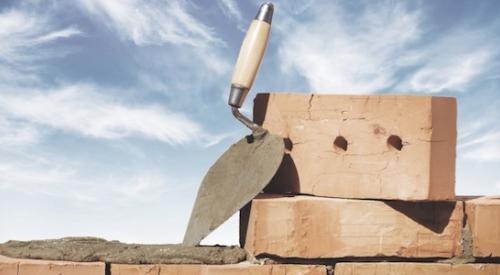"Hey Mom! I wanna be a concrete finisher!"
Newsflash!
You aren’t going to believe this, but in the past two weeks I have been told that three completely different markets absolutely, positively, for sure have the greatest trade shortage in the United States.
Let’s see, that makes probably 20 that I’ve heard claim the unfortunate distinction in the past year alone. To tell you the truth, I have no idea just which market has it the worst. In one market, the problem is roofers, in another it’s framers - and no one can find masons, so it seems.
How do we measure this to know for sure? I’ve never seen it. We’d have to somehow figure labor supply bucked up against housing demand. The demand numbers we have, but the labor supply is too much of a moving target, especially in non-union markets, which now constitute about two-thirds of the country. In fact, in some markets, a significant part of the labor supply does not exist, as far as the government is concerned. I guess I should be careful what I advocate here, but how do you blame a builder or trade for using illegal aliens, given a sub 2% unemployment rate?
Darn Demographics
What concerns me, is that some people are suggesting that the worst is over. They assume that the first decade of the new century will have to be better than the 90s. But I can tell you with almost total certainty, that it’s going to get worse before it gets better. How do I know?
First, we are right in the middle of the fifth consecutive "last big year in housing." Darn those demographics! People are not behaving properly. The economy keeps growing and people keep buying. What’s a poor builder to do? The baby boomers are coming into cash through inheritance and retirement plans in numbers that are unheard of in our nation’s history, which means second homes. It used to be rare for people to have second homes. Around here, as in most places, it is getting common. In Michigan, everyone talks about "going up North." At the rate we are going, people up there are going to have to head back south to escape the crowds.
People are buying homes that they simply didn’t or couldn’t in the past. Divorced couples used to go to apartments. Now they go to two homes. Young couples used to get married and then save up for a house. Now, many of them buy the house and then save up to get married. (I’m not THAT old, and this still strikes me as strange and unnatural way to do things.) And medical technology and home health care are allowing people to stay in their homes much longer than before. I have seven relatives in their 80s and 90s, and every single one of them still lives in their own home. Didn’t used to be. So barring some major economic catastrophe, don’t expect a major drop in demand anytime soon.
Trade Disease: Why Trade Schools Are Fading
What about supply? Well, I have harped ad nauseam over the past years about how trade schools have fallen out of favor and no one wants to be a trade any more. At my kids’ high school, if one of the students said, "I think I’ll be a carpenter or a plumber," they would be treated like they had a disease!
I know a very progressive builder who wanted to work with a local suburban high school to set up a booth on trade careers and education during the "college fair." The principal went into a panic. He challenged the builder to imagine what would happen to the principal if a bunch of kids came home from college night and said, "Hey Mom, guess what? You can spend the college fund on vacation, I’m going to be a concrete finisher!"
There were some very intriguing statistics in the paper today for the southeast Michigan metropolitan area, my home base. We have been enjoying great economics here for 10 years. No one can quite believe how the building boom just keeps going.
What the statistics show about the aging population is disturbing. From 1990 to 2000, the number of 25-39 year olds dropped 9%. The forecast for the same age group from 2000 until 2010 is an even greater drop—11%! Go drive around one of your sites. You’ll find that 80% of the daily trade labor falls into that very age group. I don’t have the statistics handy for the nation as a whole, but they can’t be too much different.
So trade schools continue to fade while the labor pool gets smaller and smaller. Meanwhile, the building boom goes on. Who’s got the power, now? Obvious, right? Well, things aren’t always as they seem.
Builders tend to fall into two groups. The first are the ones with "big boy" swagger, who still move through a market thinking and pretending that they are the 800 pound gorilla that dictates "the way it’s gonna be." That’s not working very well, because the suppliers and trades figure out their game really quickly. I have a friend named Dan in a major, high-growth market, who owns a huge, high-quality, very successful company supplying both labor and material to many of the biggest builders. Last week he told me the names of two of the top 10 builders in the United States that he won’t even open a bid package from. He used to go to the trouble to return it. Now he just trashes it - and they wonder why. These companies are literally desperate for his services, but have never bothered to sit down with him and find out why he isn’t interested in their work.
The second group adopts more of a "what can be done?" attitude. Que sera sera. They keep sending out as many bids as they can and just take what they can get. Many companies that I otherwise consider very professional, accept suppliers and trades who, quite frankly, do a marginal job and don’t appreciate their business. They accept it because they believe they have no power - so they don’t. It’s like the famous Henry Ford quote, "If you think you can - or you think you can’t - you are right." These builders have decided they can’t, and so their destiny is fulfilled.
But there is a third, smaller group of builders who take an entirely different approach. For shorthand, I’ll call it the "Builder of Choice" strategy. They have discovered that there are some very significant things within their control that the best suppliers and trades care about. By doggedly pursuing those things, they can attract more suppliers and trades than they need, enabling them to pick and chose and build solid relationships with the best, even in an ever-deepening trade shortage.
What are suppliers and trades looking for? I’d categorize it under these headings: Sanity (especially in regard to schedule and building site management), Support, Relationship and Communication.
Notice I did not say Rewards. That’s because the money is available anywhere at any time from everybody—not just you. But the other four are in all too short supply. Using these, you can become the Builder of Choice and beat the supplier and trade shortage.













